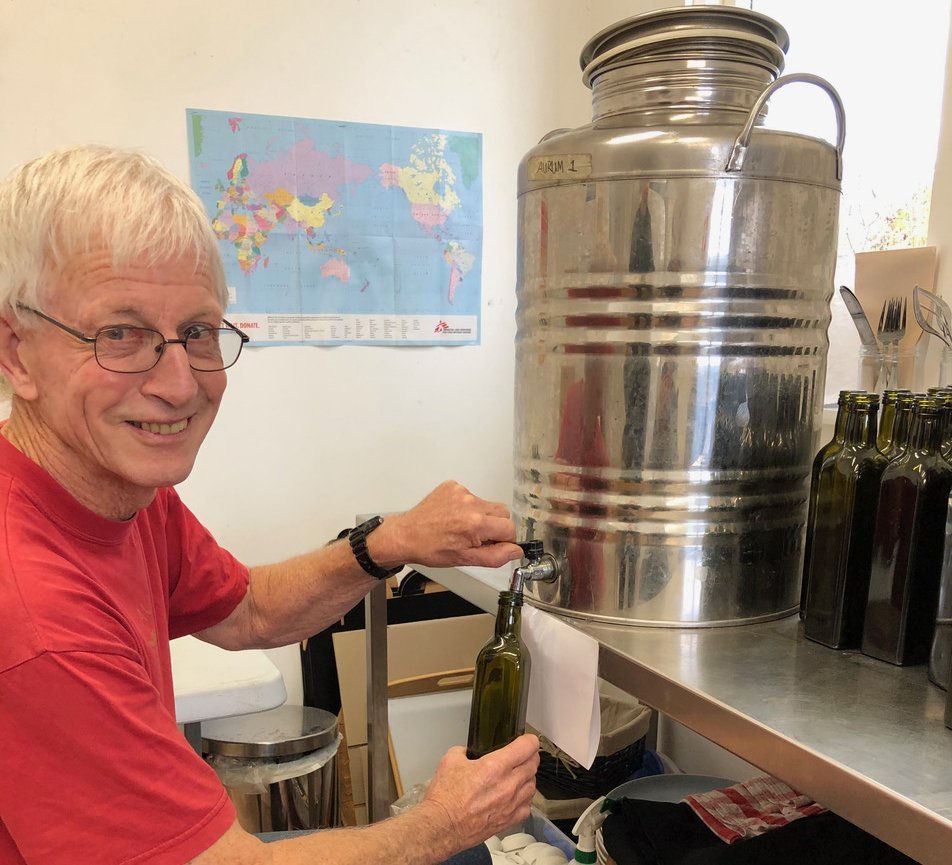Rich, olivey and peppery, Central Otago extra virgin olive oil is different from oil grown elsewhere Charmian Smith discovers.

At the other end of the long, vibrating olive press, the just-picked, green and black olives are tipped into the hopper, leaves blown off, washed, pits and all hammered to a pulp, then churned and squeezed to release the oil.
Pressing olives for extra virgin olive oil is a simple mechanical process, millennia old, except, instead of hard labour, modern technology makes for a cleaner, faster process.
I attended the Central Otago Olive Growers community open day at Queen’s Birthday. People brought olives from their own trees or picked them from nearby trees and took them to the community press run by Steve and Olivia Morris of Ollie’s Olives at Smith’s Way by Lake Dunstan.
Some attendees were new to the industry having bought a property with olive trees already planted, while others were thinking of planting some.
One woman said she never knew olive oil could be so green or its flavour so mind-blowing - a world of difference from supermarket oils, even those labelled extra virgin.

Central Otago olive oil is different from the mild, golden oils from up north because of the climate, says Olivia who offers tastings of oils from around the country to compare.
Joan Lawrence and husband Tony, who grow olives beside their Aurum winery just outside Cromwell and sell it at their cellar door, are among the experienced growers on hand to answer questions about growing and picking olives.
Olives can be painstakingly picked by hand into a bag so they do not get bruised, which is best if you want to use them for table olives.
For oil they can be pulled off the trees with a small plastic rake or a long-handled electric picker with vibrating wire fingers that dislodge the fruit on to nets spread over the ground below.
People with larger groves, like Stephen Clark of Cairnmuir Olives, use a hydraulically-driven net shaped like an upturned umbrella clamped around the tree and a large, mechanical shaker that produces high frequency, small amplitude shaking, so the tree seems to shimmer rather than vibrate.
Olives for oil are best picked when about a third are still green, a third purple and a third black. Black ones tend to be full of oil but can lack flavour while green ones contribute to the grassy peppery flavours of southern oils.
Sometimes this depends on where the olives are on the tree — ripe black ones exposed to the sun on the outside or greener ones among the leaves, but different varieties also produce ripe olives of different colours. At Queen’s Birthday leccino were already black, while frantoio were green turning to purple with tinges of black.
While many varieties of olive were trialled in Central when pioneers like John and Dallas Fairmaid started in the late 1990s, the Italian varieties frantoio, leccino and pendolino are now predominant as they can withstand winter frosts, but there are also Spanish manzanilla, Israeli barnea and South Australian verdale trees among the 15 varieties planted locally.
Frost is one of the major problems for almost any crop grown in Central, especially olives that ripen in late May or early June.
Tony Lawrence says it’s often a game between getting them ripe enough through the frosts but before the birds eat them. Planting on a slope may let the frost drain away.
Frost damage can be patchy, especially if the frozen olives thaw quickly when hit by the sun, but sometimes when there’s a mist they can survive, Joan says.
She explains if you slit ripe olives with your fingernail and squeeze, a grassy, olivey mix of oil and water oozes out. Frost-damaged olives are brown inside and nothing oozes out. If pressed with good olives they can taint the oil.
Irrigation and pruning are also important for the health and size of crop.
Olive trees are wind-pollinated so the canopy needs to be open and this also reduces black scale, the only disease that affects trees in the South, she said.
ONE of the largest producers, Sandy Black of Dunford Grove, who sells oil at the Otago Farmers Market in Dunedin, says trees also need good soil, not just dirt. He and partner Jocelyn Robinson applied bacterial teas when they first took over their grove.
“We had dirt that was totally denatured with Roundup. It killed all the micro-rhizomes but in a few months the transformation was amazing. We went from dirt to soil, the worm activity and mushrooms coming out of nowhere. Now we are following an organic programme of fertilisation and feeding the plants,” he said.
After initial enthusiastic planting in the early 2000s, some groves were neglected as people got older or moved on. Olive trees require a lot of maintenance and the land is worth more bare, Tony said.
On average, it takes about 10kg of olives to produce one litre of oil in Central.
Apart from around 12 commercial growers, of which maybe four are large, most of the smaller growers produce oil for themselves and their friends.
Small volumes of oil are difficult to market, Joan says, and adds “We are all here because we love a great lifestyle and growing an olive is an inspiring thing to do. It’s an ancient thing and you get an enormous pleasure in pouring your own olive oil.”
“They are just the most exquisite tree, especially this time of the year when they are all silvery.”















